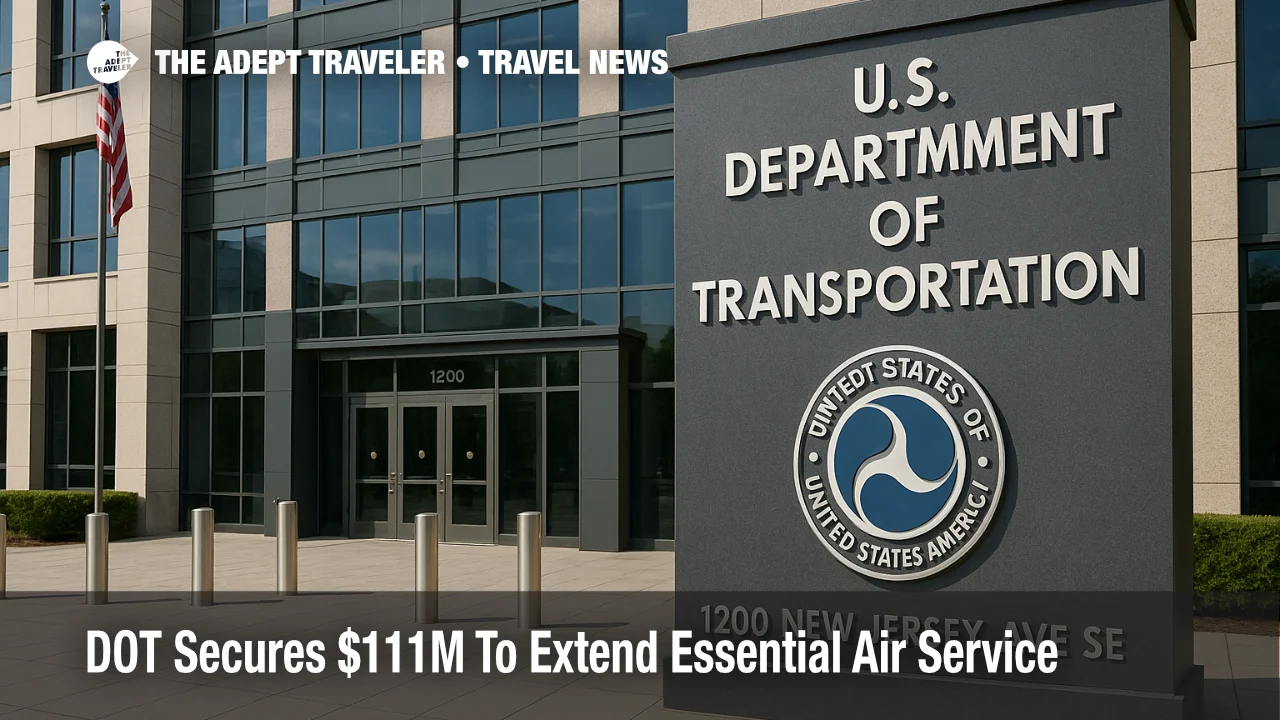DOT Secures $111M To Extend Essential Air Service

Key points
- DOT said it secured an additional $111 million for the Essential Air Service program
- The new funding follows an October 8 stopgap of $41 million during the shutdown
- DOT and airport groups indicate funds should carry EAS reimbursements through November 18
- EAS subsidizes air links to about 170 rural communities, including 65 in Alaska
- Airline leaders met October 30 with Vice President JD Vance and Secretary Sean Duffy
Impact
- Who Is Affected
- Travelers using subsidized flights at small and remote U.S. airports, with outsized effects in Alaska
- Key Dates
- Shutdown began October 1; $41M secured October 8; $111M secured October 30; funding expected through November 18
- What To Do
- If booked on an EAS route, monitor messages from your carrier and airport, confirm schedules, and verify ticket protection if service changes
- Watch Next
- Whether Congress restores regular appropriations or DOT identifies further bridge funds beyond November 18
- Connections & Alternatives
- For tight connections, consider earlier flights or nearby non-EAS airports where feasible
The U.S. Department of Transportation said it has secured an additional $111 million to sustain the Essential Air Service program, extending subsidies that keep flights operating to small and remote communities during the federal shutdown. The announcement on October 30 follows an earlier $41 million stopgap on October 8 that forestalled an October 12 lapse and kept reimbursements flowing into early November. DOT and airport groups now indicate the new funds should carry EAS payments through November 18, reducing near-term risk of cancellations on subsidized routes while lawmakers negotiate.
Essential Air Service, who it helps
Essential Air Service, EAS, pays carriers to fly routes that would not be commercially viable on their own, preserving basic connectivity for roughly 170 communities nationwide, including about 65 in Alaska where road links are limited. The program typically receives several hundred million dollars per year and is administered via contracts between DOT and participating airlines that specify schedules, aircraft, and subsidy rates. During the shutdown, DOT has warned that absent bridge funds it cannot access all appropriated money, which is why short-term injections have been necessary to keep reimbursements going.
Latest developments
DOT's October 30 press release framed the $111 million as preventing a funding lapse that could have forced carriers to suspend service. Trade and industry outlets echoed the timing and the near-term runway to November 18, citing agency notices to airports and operators. Business travel and airline publications reported the same amount and window, underscoring that passengers on EAS routes should see schedules continue while the new funds last.
Industry posture and traveler takeaways
As pressure mounted, airline CEOs and trade groups pressed for an end to the shutdown and met with Vice President JD Vance and Transportation Secretary Sean Duffy on October 30 to discuss system impacts ahead of the holiday peak. For travelers, the practical guidance is straightforward. If you fly to or from an EAS community, keep an eye on airline emails and airport advisories, consider padding connections at major hubs, and, if your plans are flexible, choose earlier departures in case day-of staffing ripples extend your journey time. Relatedly, if you are connecting between EAS flights and mainline services, review ticket protection and rebooking rules so you know your options should schedules shift.
Background
Why does a shutdown threaten EAS when Congress appropriates money annually. DOT has explained that during a lapse in certain government functions, it cannot access all appropriated funds in the normal way. The department initially projected an October 12 cutoff, then obtained $41 million on October 8 to keep payments going "into early November," and has now added $111 million, which airport groups say should cover reimbursements through November 18. If negotiations stall again, DOT could seek further bridge funds. Travelers should watch both federal updates and their local airport's notices.
Related coverage
For broader system effects of the shutdown on air travel, including staffing strain and rolling ground delay programs at busy hubs, see our latest analysis.
- Eurostar London-Paris cuts begin, day-one cancellations hit midday bank
- Shutdown pressure continues to ripple into hub ops, watch Austin repeat delays
Final thoughts
DOT's $111 million bridge buys time for Essential Air Service communities, particularly in Alaska, reducing near-term risk while Congress debates a longer fix. If you rely on an EAS route, confirm your flights, add connection buffers, and watch for another funding update before November 18.
Sources
- U.S. Transportation Secretary Sean P. Duffy Saves Essential Air Service from Funding Lapse Due to Democrat-Led Shutdown
- U.S. Transportation Secretary Sean P. Duffy Secures Critical Funding for Essential Air Service After Democrat-Led Shutdown Threatened Lapse in Funding
- DOT Indicates EAS Funding Available Through November 18
- DOT Secures $111M in Additional EAS Funding
- Amid government shutdown, DOT secures money for Essential Air Service
- US says subsidies for rural airline service to expire as soon as Sunday
- Vance to meet with Duffy, aviation leaders as shutdown gravely impacts crucial industry
